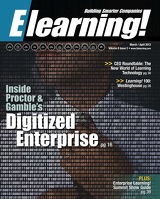Elearning! Magazine: Building Smarter Companies via Learning & Workplace Technologies.
Page 35 of 52
TipsTalent Retention 6
Technology-Enabled Best Practices for
Retention
formance and alignment with corporate goals, to providing career and promotion oppor- tunities, to measuring program success. In the whitepaper titled
The importance of top per- former retention is a topic that consistently leads in HR and business surveys alike. Notably, more than 1,000 CEOs were asked: "How important are the following sources of competi- tive advantage in sustaining your growth over the long term?" The number one response — chosen by 97 per- cent — was "access to, and retention of, key talent."1 Talent retention is critically
important for all organizations for two main reasons: 1) Turnover is expensive. 2) Top performers drive
business performance. Although estimated financial
impacts from turnover fluctu- ate depending on industry, position, and location, esti- mates range from 30 percent to 250 percent of annual salary.2 Turnover costs mount steeply arising from the direct replace- ment costs of talent acquisition, the opportunity costs of vacant positions and time to produc- tivity, and — more broadly — lost business performance. The impact of quality per- formers was crystallized in
McKinsey's seminal War for Talent study. It found that in the opinion of senior man- agers, high performers out- perform average performers by a wide margin. According to the study, high performers in operations roles are able to increase productivity by 40 percent; high performers in management roles increase profits by 49 percent; and in sales positions, high perform- ers are responsible for 67 per- cent greater revenue.3 Constrained economic con-
ditions further highlight the need for organizations to keep their best people as companies strive to control costs and increase productivity. Talent management strategies address this dual agenda directly. For example, a Taleo Research global survey found 70 percent of respondents see an increased need to retain top performers by driving focus on performance management and career planning in a low growth economy.4 Because low talent retention
produces a substantial drain on corporate resources, lead-
ers need to know what prac- tices work and what they should focus on to retain and motivate their workforce. For instance, a talent management strategy that allows employees to build a network, seek and find mentors, and help them grow and develop while feel- ing more connected and engaged is one means of retaining talent. Many approaches have been
explored as levers to increase retention, including compen- sation packages and rewards, benefits, telecommuting options, and work/life-balance initiatives. Each may have a place in a company's portfolio of retention strategies. Today, certain talent man-
agement practices that utilize self-service software as a serv- ice (SaaS) interfaces can be effective and extensible throughout organizations. Specifically, retention strategies can be carried out through tal- ent management practices sup- ported by a robust technology platform. These practices span the talent lifecycle from hiring, to managing employee per-
1 2 3
4 5 6
"Talent Retention: Six Technology-Enabled Best Practices," we reveal the six key practices that organizations can implement with technolo- gy support to retain their top talent:
Recruit the right people in the first place.
Improve the line manager's ability to manage.
Give employee's constant feedback about clear, mean-
ingful goals.
Empower employees to manage their own careers.
Proactively drive talent mobility.
Continuously measure and improve retention strategies.
—To learn more, download Taleo's free whitepaper at: http://www.2elearning.com/ www/resources/research-white- papers/browse/1.html
Source: 1
12th Annual Global CEO Survey 2009; 2
New York Times, Oct. 24, 2008; 3
Company, 1998; 4
Pricewaterhouse Coopers "Employees leaving? Here's
why and what you can do," The "The War for Talent," McKinsey &
Global Unified
Talent Management Survey, 2008 by Taleo Research with Human Capital Institute (HCI), Business Intelligence, Markess International, Quantum Market Research
Elearning! March / April 2012 35
